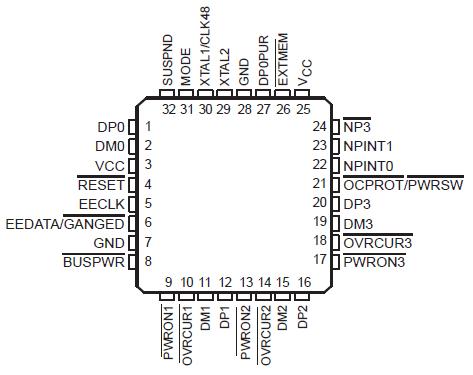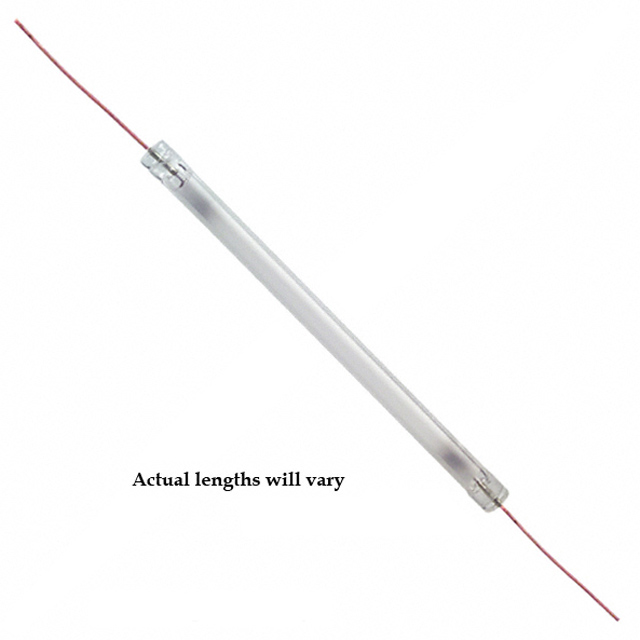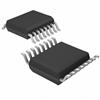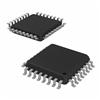Features: ` Universal Serial Bus (USB) Version 1.1 Compliant
` Integrated USB Transceivers
` 3.3-V Low Power ASIC Logic
` One Upstream Port and 2-3 Programmable Downstream Ports Total Number of Ports (2 or 3) Selected by Input Pin Total Number of Permanently Connected Ports Is Selected by 2 Input Pins
` Two Power Source Modes Self-Powered Mode Bus-Powered Mode
` All Downstream Ports Support Full-Speed and Low-Speed Operations
` Power Switching and Overcurrent Reporting Is Provided Per Port or Ganged
` Supports Suspend and Resume Operations
` Suspend Status Terminal Available for External Logic Power Down
` Supports Custom Vendor ID and Product ID With External Serial EEPROM
` 3-State EEPROM Interface Allows EEPROM Sharing
` Push-Pull Outputs for PWRON Eliminate the Need for External Pullup Resistors
` Noise Filtering on OVRCUR Provides Immunity to Voltage Spikes
` Supports 6 MHz Operation Through Crystal Input or 48 MHz Input Clock
` Output Pin Available to Disable External Pullup Resister on DP0 for 3 ms After Reset or After Change on BUSPWR and Enable Easy Implementation of On-Board Bus/Self Power Dynamic Switching Circuitry
` Available in 32-Pin LQFP Package With a 0.8 mm Pin Pitch (JEDEC S-PQFP-G For Low-Profile Quad Flat Pack)Pinout SpecificationsSupply voltage range, VCC (see Note 1) . . . . . . . . . . . . . . . . . . 0.5 V to 3.6 V
SpecificationsSupply voltage range, VCC (see Note 1) . . . . . . . . . . . . . . . . . . 0.5 V to 3.6 V
Input voltage range, VI . . . . . . .. . . . . . . .. . . . . . . . . . . 0.5 V to VCC + 0.5 V
Output voltage range, VO . . . . . . . . . . . . . . . . . . . . . . . . 0.5 V to VCC + 0.5 V
Input clamp current, IIK, (VI < 0 V or VI > VCC) . . .. . . . . . . . . . . . . . . . ±20 mA
Output clamp current, IOK, (VO < 0 V or VO > VCC) . . . . . . . . . . . . . . . . ±20 mA
Storage temperature range, Tstg . . . . . . . . . . . . . . .. . . . . . . . . . 65to 150
Operating free-air temperature range, TA . . . . . . ... . . . . . . . . . . . . . 0 to 70
† Stresses beyond those listed under "absolute maximum ratings" may cause permanent damage to the device. These are stress ratings only, and functional operation of the device at these or any other conditions beyond those indicated under "recommended operating conditions" is not implied. Exposure to absolute-maximum-rated conditions for extended periods may affect device reliability.
NOTE 3: All voltage levels are with respect to GND.DescriptionThe TUSB2036 hub is a 3.3-V CMOS device that provides up to three down stream ports in compliance with the USB version 1.1 specification. Because this device is implemented with a digital state machine instead of a microcontroller, no firmware programming is required. Fully compliant USB transceivers are integrated into the ASIC for all upstream and downstream ports. The downstream ports support both full-speed and low-speed devices by automatically setting the slew rate according to the speed of the device attached to the ports. The configuration of the BUSPWR terminal selects either the bus-powered or the self-powered mode. The introduction of the DP0 pull-up resistor disable pin, DP0PUR, makes it much easier to implement an on-board bus/self-power dynamic-switching circuitry. With the new function pin, the end equipment vendor can reduce the total board cost while adding additional product value.
The EXTMEM (Pin 26) enables or disables the optional EEPROM interface. When EXTMEM is high, the vendor and product IDs (VID and PID) use defaults, such that the message displayed during enumeration is General Purpose USB Hub. For this configuration, pin 6 functions as the GANGED input pin and the EECLK (Pin 5) is unused. If custom VID and PID descriptors are desired, the EXTMEM must be tied low (EXTMEM = 0) and a SGS Thompson M93C46 or equivalent EEPROM must be used to store the programmable VID, PID and GANGED value. For this configuration, pin 5 and pin 6 function as the EEPROM interface signals with pin 5 as EECLK and pin 6 as EEDATA respectively.
The TUSB2036 supports both bus-powered and self-powered modes. External power management devices such as the TPS2044 are required to control the 5 V-power source switching (on/off) to the downstream ports and detect over-current condition from the downstream ports individually or ganged. Outputs from external power devices provide over-current inputs to the TUSB2036 OVRCUR pins in case of an over-current condition,the corresponding PWRON pins will be disabled by the TUSB2036. In the ganged mode, all PWRON signals transitions simultaneously, and any OVRCUR input can be used. In the nonganged mode, the PWRON outputs and OVRCUR inputs operate on a per port basis.
The TUSB2036 provides the flexibility of using either a 6-MHz or a 48-MHz clock. The logic level of the MODE terminal controls the selection of the clock source. When MODE is low, the output of the internal APLL circuitry is selected to drive the internal core of the chip. When MODE is high, the XTAL1 input is selected as the input clock source and the APLL circuitry is powered down and bypassed. The internal oscillator cell is also powered down while MODE is high. For 6-MHz operation, TUSB2036 requires a 6-MHz clock signal on XTAL1 pin (with XTAL2 for a crystal) from which its internal APLL circuitry generates a 48 MHz internal clock to sample the data from the upstream port. For 48-MHz operation, the clock cannot be generated with a crystal, using the XTAL2 output, since the internal oscillator cell only supports fundamental frequency. If low power suspend and resume are desired, a passive crystal or resonator must be used, although the hub supports the flexibility of using any device that generates a 6-MHz clock. Because most oscillators cannot be stopped while power is on, their use prohibits low-power suspend, which depends on disabling the clock. When the oscillator is used, by connecting its output to XTAL1 terminal and leaving XTAL2 terminal open, its TTL output level can not exceed 3.6 V. If a 6 MHz oscillator is used, it must be stopped at logic low whenever SUSPND is high. For crystal or resonator implementations, the XTAL1 terminal is the input and the XTAL2 terminal is used as the feedback path. A sample crystal tuning circuit is shown in Figure 7

 TUSB2036 Data Sheet
TUSB2036 Data Sheet








